I never did finish writing my review of Ancillary Mercy, the final book of Ann Leckie‘s Imperial Raadch trilogy, but here is part of its beginning:
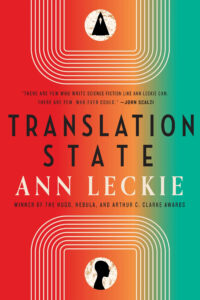
Presger Translator Zeiat may be my favorite character in science fiction from 2015. I’ll have to think about it a little while more to be sure, but she is so vividly hilarious that off the top of my head, I’m having a tough time recalling a science fictional character who has brought me more delight. The characters around Zeiat, however, more likely find her unnerving because she could cause all of them to be destroyed without any great effort on her part; indeed, she might do it without even properly noticing that she had. A bit like a porcelain teacup full of nitroglycerin, being carried around by a rambunctious puppy.
In the universe that Ann Leckie has written about in Ancillary Mercy (and, of course, in its predecessors Ancillary Sword and Ancilary Justice), the Presger are immensely powerful aliens who caused great destruction in human space before that misunderstanding was cleared up by treaty, some 20 years before the action of the novels. The Translators mediate between the humans and the Presger; they look human, but they are clearly not, and their thought processes are unnervingly alien.
Not quite a decade later, Leckie returned to that universe with Translation State, although to a part of it far from the Raadch. (Her 2017 novel Provenance, which I have not read, is also set in the same universe.) While the title implies that the Translators will play a role, and the text on the book’s back cover confirms it, Leckie starts the novel from the point of view of a human named Enae. Sie uses sie/hir pronouns and has been caretaker to hir grandmother for many years. The grandmother was the fantastically wealthy matriarch of an old and prominent family; she was also both tyrannical and petty. The extended family pretended to revere her, in hopes of inheriting. She saw through it, of course, and surprised them all by cutting them out of the will. Even more surprising was that she had long since squandered the family fortune, and had been propped up in her later years by a rich parvenu, whom she had secretly adopted as heir. The arriviste got the house and the name, which she wanted; grandmother never had to let go of the style to which she had become accustomed; the extended family got to find out about the joke, which they somehow failed to find amusing.
Continue reading
Permanent link to this article: https://www.thefrumiousconsortium.net/2025/09/01/translation-state-by-ann-leckie/
The first two pages of The Kite Runner establish that as a child in Kabul in 1975, the first-person narrator witnessed or did something life-changing, something that so indelibly marked him that he carried it into the novel’s present day, which is December 2001. The summer of that year the narrator, who is living in San Francisco, received a call from a friend in Pakistan. “I knew it wasn’t just Rahim Khan on the line. It was my past of unatoned sins.” (p. 1) The friend offers him “a way to be good again.” (p. 2) Without any further explanation, the second chapter takes readers back to the narrator’s childhood.

Hosseini sets up the first part of the novel with that introduction and jump. What did the narrator, whose name is Amir, do that was so bad? What happened to mark him for decades? What would it take for him to atone? This kind of very short framing, with most of the story happening in flashback, can be effective, and Hosseini’s version sets the stakes and stokes a reader’s curiosity. But it’s also a technique that gets used a lot: the protagonist is in a mess, now the author will take some time telling readers how they got there. For me, the approach has lost effectiveness with repetition, and I am beginning to think that authors use it because they want to grab readers quickly, as if they think a straightforward telling of the tale would not be interesting enough to hold the reader’s attention. In The Kite Runner, it’s also a sign that the author is going to lean very heavily on melodrama.
Continue reading
Permanent link to this article: https://www.thefrumiousconsortium.net/2025/08/30/the-kite-runner-by-khaled-hosseini/
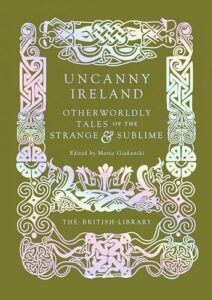 A Tantalizing Tales Part Five, dear readers! That’s a first for us over here at The Frumious Consortium, but oh what delicious books we have in store for you this week, covering tomes just published and those about to come!
A Tantalizing Tales Part Five, dear readers! That’s a first for us over here at The Frumious Consortium, but oh what delicious books we have in store for you this week, covering tomes just published and those about to come!
First is my personal favorite of the bunch — and the one I’m hoping to love enough to get a copy of for my favorite redhead, in part to repay him for the invaluable help he gave me in training for Jeopardy! — Uncanny Ireland edited by Maria Giakaniki. Subtitled Otherworldly Tales of the Strange And Sublime, this fourth volume in the British Library’s gorgeously bound Gilded Nightmares series is a fascinating compilation of twenty short pieces from the past two centuries. The contents range from accounts of weird folklore and rare reimagined myths, to classic ghost stories and modern spectral chillers from the likes of Irish literary giants like Sheridan Le Fanu, Elizabeth Bowen, W. B. Yeats, Dorothy Macardle and more.
With the weather slowly but surely getting chillier in my neck of the woods, this is the perfect book with which to welcome in autumn and the start of spooky season! Also, that gorgeous cover with its metallic accents has to be seen to be truly believed!
Continue reading
Permanent link to this article: https://www.thefrumiousconsortium.net/2025/08/29/tantalizing-tales-august-2025-part-five/
God, given the week I’ve been having, it’s so nice to be able to slip into a book about young people whose deeply felt and very real problems are solved by the end of its 300+ highly readable pages.
 So look, when I compare Alexandra Brown Chang’s debut novel By Invitation Only to Cecily Von Ziegesar’s Gossip Girl novels, I need you to understand that that is very high praise. The characters are lived in and kind and flawed and mostly just doing the best they can with the hands they’ve been dealt. Sure, some of them are born rich and feel no guilt about spending their money but my God, wouldn’t it be nice if everyone had the money they needed for food and rent and education, with extras for the frivolity that at the very least maintains the labor that fuels our capitalist hellscape?
So look, when I compare Alexandra Brown Chang’s debut novel By Invitation Only to Cecily Von Ziegesar’s Gossip Girl novels, I need you to understand that that is very high praise. The characters are lived in and kind and flawed and mostly just doing the best they can with the hands they’ve been dealt. Sure, some of them are born rich and feel no guilt about spending their money but my God, wouldn’t it be nice if everyone had the money they needed for food and rent and education, with extras for the frivolity that at the very least maintains the labor that fuels our capitalist hellscape?
One of the main characters in this book sure doesn’t have that kind of money. Despite winning the International Science Fair, Piper Woo Collins won’t be able to afford her first year at Columbia, after her scholarship was suspended due to a dispute between the school and the benefactor who was supposed to endow her funding. She’s understandably distraught, and frantically trying to figure out what to do instead. Her dad’s a hardworking EMT while she herself works at the local Claire’s, but higher education in this country is absurdly expensive even before taking into account the attendant costs of living.
Meanwhile in Paris, the exclusive organization known as Le Danse des Debutantes is trying to rehabilitate its image after one scandal too many. In an effort to show that they do care about the common person, they extend an invitation to Piper to attend the most exclusive debutante ball in the world. Piper thinks it’s a joke, until they offer to pay for her first year at Columbia. That, however, is entirely contingent on her making a good impression on their behalf.
Continue reading
Permanent link to this article: https://www.thefrumiousconsortium.net/2025/08/28/by-invitation-only-by-alexandra-brown-chang/
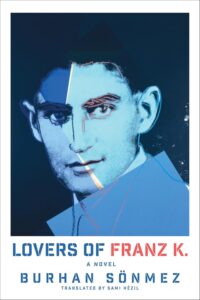 translated from the original Kurdish by Sami Hezil.
translated from the original Kurdish by Sami Hezil.
It feels a little strange to be talking about a(nother) book on the subject of the legacies of the departed, especially since this definitely takes the opposite tack of yesterday’s What Happens After? That book talked about grief and acceptance, whereas this speaks of guilt and vengeance. Weirdly, those have also been preoccupations of mine, which might go some way to explaining the reading hangover I’ve been feeling recently.
Lovers Of Franz K goes a step further from my personal dilemmas to speak of the impact of writers on their audiences. The Franz of the title is the celebrated author Franz Kafka, ofc, whose will requested that his unpublished works be destroyed after his death. His best friend and heir Max Brod went ahead and had them published anyway. The literary world was torn: should Brod have honored Kafka’s wishes, or had he been right to share these last glimmers of genius with the world?
The book itself opens with the arrest of a young man named Ferdy Kaplan, after the fatal shooting of a student in 1960s West Berlin. Ferdy is Turkish and assumed to be an anti-Semitic radical hiding others of his cell. He mocks the interrogating Police Commissioner Muller’s lines of inquiry, even as he expresses regret for what he’s done.
Continue reading
Permanent link to this article: https://www.thefrumiousconsortium.net/2025/08/27/lovers-of-franz-k-by-burhan-sonmez/
I really needed to read this terrific book, on the heels of Lauren Munoz’ absolutely devastating (to me) YA mystery Very Dangerous Things, which triggered yet another round of grief over a long-ago loss that I’m still trying to grapple with.
 The nice thing about What Happens After? is that it doesn’t try to dive into rhetoricals of what happens to the person who leaves us. Everyone’s got their own ideas of the afterlife, and this book is not at all interested in litigating any of that. Instead, this thoughtful, tender children’s picture book discusses what happens to us survivors in the wake of loss, and how we can keep going while still honoring and loving the ones who’ve passed away.
The nice thing about What Happens After? is that it doesn’t try to dive into rhetoricals of what happens to the person who leaves us. Everyone’s got their own ideas of the afterlife, and this book is not at all interested in litigating any of that. Instead, this thoughtful, tender children’s picture book discusses what happens to us survivors in the wake of loss, and how we can keep going while still honoring and loving the ones who’ve passed away.
(I may or may not be tearing up while writing this. It has been a weird and hard few weeks of it, y’all.)
The prose is simple and matter-of-fact. Diane Namm confronts loss head-on, never shying away from the inevitability of death and its attendant grief. She acknowledges how hard it can be for those left behind, and that it sometimes takes a really, really long time for things to stop feeling so hard. But then she does something beautiful by talking about how we can remember our gone-away loved ones still, and how we can continue living with the joy of their memories in our hearts.
Continue reading
Permanent link to this article: https://www.thefrumiousconsortium.net/2025/08/26/what-happens-after-by-diane-namm-laura-jager/
It is tempting to begin this roundup with the timeworn lede, “Comics! They’re not just for kids any more!” I’ve been rolling my eyes at that one for decades at this point, as mainstream reviewers seemingly “discover” that sophisticated graphic novels exist, over and over again.
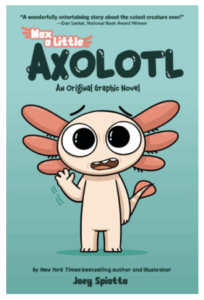 In fact, the graphic novel is a form that can reach readers in many, many eras of their lives, and I want to highlight here some of the excellent ones to keep on your radar this Fall and beyond: For the youth, Max, A Little Axolotl is coming out next week on September 2 for the early readers in your life and Trung Le Nguyen’s next YA graphic novel, Angelica and the Bear Prince is coming out October 7. For new adults, The Corus Wave is coming out later that month on October 21, and grown ups can also look forward to reading Martyr Loser King by multitalented musicians Saul Williams and Morgan Sorne, coming out next Spring on April 28.
In fact, the graphic novel is a form that can reach readers in many, many eras of their lives, and I want to highlight here some of the excellent ones to keep on your radar this Fall and beyond: For the youth, Max, A Little Axolotl is coming out next week on September 2 for the early readers in your life and Trung Le Nguyen’s next YA graphic novel, Angelica and the Bear Prince is coming out October 7. For new adults, The Corus Wave is coming out later that month on October 21, and grown ups can also look forward to reading Martyr Loser King by multitalented musicians Saul Williams and Morgan Sorne, coming out next Spring on April 28.
Axolotls seems to be having a cultural moment the same way llamas were a few years ago. I’m into it, as axolotls are inherently adorable, and appreciating them implies supporting sustainability measures that will protect their habitat. In Max, A Little Axolotl, Max is rescued from his habitat being destroyed and introduced into a school of diverse sea creatures. He’s shy and feels like an outlier because he’s the only axolotl, and doesn’t know much about his own species. It takes making friends to help him adjust. Published by Scholastic, Max, A Little Axolotl has a straightforward story with cute illustrations that will appeal widely to early readers.
Continue reading
Permanent link to this article: https://www.thefrumiousconsortium.net/2025/08/25/18443/
Hello, dear readers! We’re well on our way to a five-parter of Tantalizing Titles this August (with a bonus reissue recap earlier this week!) but let’s not get too, too far ahead of ourselves. Today we’re featuring seven brilliant books that have either just published or will be coming to bookshelves this coming Tuesday!
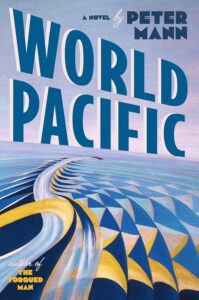 We start off with the newest historical novel from the author of the phenomenal The Torqued Man. Peter Mann’s World Pacific is set in San Francisco and the Asian Pacific during the lead up to the Second World War, and is told from the points of view of three indelible and very different characters.
We start off with the newest historical novel from the author of the phenomenal The Torqued Man. Peter Mann’s World Pacific is set in San Francisco and the Asian Pacific during the lead up to the Second World War, and is told from the points of view of three indelible and very different characters.
Richard “Dicky” Halifax is attempting to sail a Chinese junk from Hong Kong to San Francisco, as part of the World’s Fair festivities on Treasure Island, when he vanishes in the Pacific. This writer of boys’ adventures is a man of bravado and breezy prose styles. Both his machinations and his letters to his young readers keep his voice alive, even as his disappearance upends the lives of those left behind in his wake.
Hildegard Rauch is an émigré painter and the daughter of Germany’s greatest living writer in exile. After she finds her twin brother in a coma after an attempted suicide — and the mysterious note he left behind — she embarks on a search for the truth about his relationship with Richard Halifax and the dangerous secret her twin entrusted to the writer before his voyage.
British Intelligence officer Simon Faulk has been assigned to ferret out Nazi spies in California. He learns of the arrival of a mysterious American agent from across the Pacific, part of a joint German- Japanese operation. As all three paths converge, the novel explores the many forms in which shipwreck, exile and betrayal beset us, and the stories that we tell ourselves in order to stay afloat.
Continue reading
Permanent link to this article: https://www.thefrumiousconsortium.net/2025/08/22/tantalizing-tales-august-2025-part-four/
I had a great time at Flame Con this past weekend! As planned, I went both days, Saturday solo and Sunday with my kid. On Saturday my good time started even before I entered the Con, chatting in the press pass line with Erica Friedman (LGBTQ Comics Tastemaker) of okazu.yuricon.com.
When I got in, I oriented myself with the map, looking at how FlameCon was spread out through three floors of the Sheraton New York Times Square this year. The entry level floor was mostly for gaming rooms, one floor up was the exhibitor space, and above that, the third floor was mostly programming, with rooms for panels and workshops.
 I went first to a session called “Vampires, Werewolves and Frank N Furters—Oh, My!” moderated by Josh Trujillo (with microphone) and featuring from left to right, Brent Lambert, Mags Visaggio, Bradley Clayton and Sina Grace. They chatted about horror generally and its appeal to queer readings. I was excited to learn that Mags Visaggio is working on two exciting projects right now, one a graphic novel sequel to Rocky Horror, and the other a gigantic horror novel called Long Island Baby. I look forward to reading both!
I went first to a session called “Vampires, Werewolves and Frank N Furters—Oh, My!” moderated by Josh Trujillo (with microphone) and featuring from left to right, Brent Lambert, Mags Visaggio, Bradley Clayton and Sina Grace. They chatted about horror generally and its appeal to queer readings. I was excited to learn that Mags Visaggio is working on two exciting projects right now, one a graphic novel sequel to Rocky Horror, and the other a gigantic horror novel called Long Island Baby. I look forward to reading both!
Continue reading
Permanent link to this article: https://www.thefrumiousconsortium.net/2025/08/21/flame-con-2025/
Given my literary consumption of recent years, I’m genuinely wondering whether I ought to pivot away from my usual mental palate cleansers of classic/cozy crime in favor of horror anthologies like this one! This volume certainly acted like a much needed reset on my brain, serving up short, sharp and entirely self-sufficient diversions to give my weary mind the low commitment but high reward reading it desperately needed.
 As overseen by Ben Abernathy, the ten comics collected here fulfil the Creepshow remit with aplomb. For those unfamiliar with the concept, Creepshow first debuted as a Stephen King-written and George A Romero-directed anthology movie in the early 1980s. It was conceptualized as an homage to the EC horror comics of the 1950s, and was successful enough to spawn several sequels and, in a nice full-circle moment, a comic of its own.
As overseen by Ben Abernathy, the ten comics collected here fulfil the Creepshow remit with aplomb. For those unfamiliar with the concept, Creepshow first debuted as a Stephen King-written and George A Romero-directed anthology movie in the early 1980s. It was conceptualized as an homage to the EC horror comics of the 1950s, and was successful enough to spawn several sequels and, in a nice full-circle moment, a comic of its own.
Creepshow was revived as a television show in 2019, which is where this latest comics iteration comes in. Greg Nicotero and Brian Witten, the producers of that show, have also cleverly solicited for writers and artists to contribute to accompanying print anthologies, of which this is the third. Each volume so far has showcased some of the best talent in comics today. This one is no different, with a stacked line-up that includes Chip Zdarsky, Mike Carey and Kami Garcia, among others. Shout-out as well to Pat Brousseau who lettered every story but one here, keeping an excellent sense of continuity going almost entirely throughout.
Continue reading
Permanent link to this article: https://www.thefrumiousconsortium.net/2025/08/20/creepshow-vol-3-edited-by-ben-abernathy/










